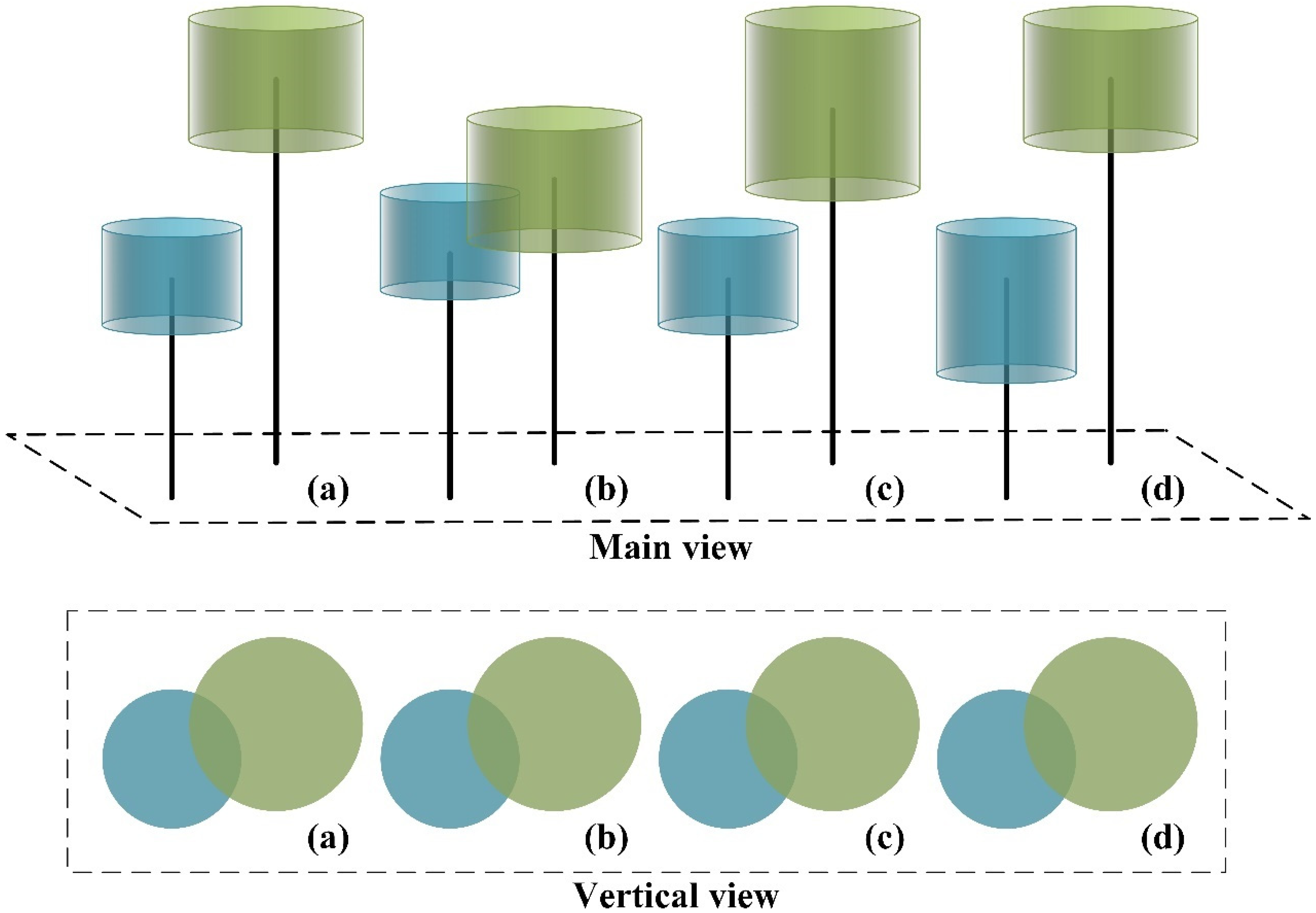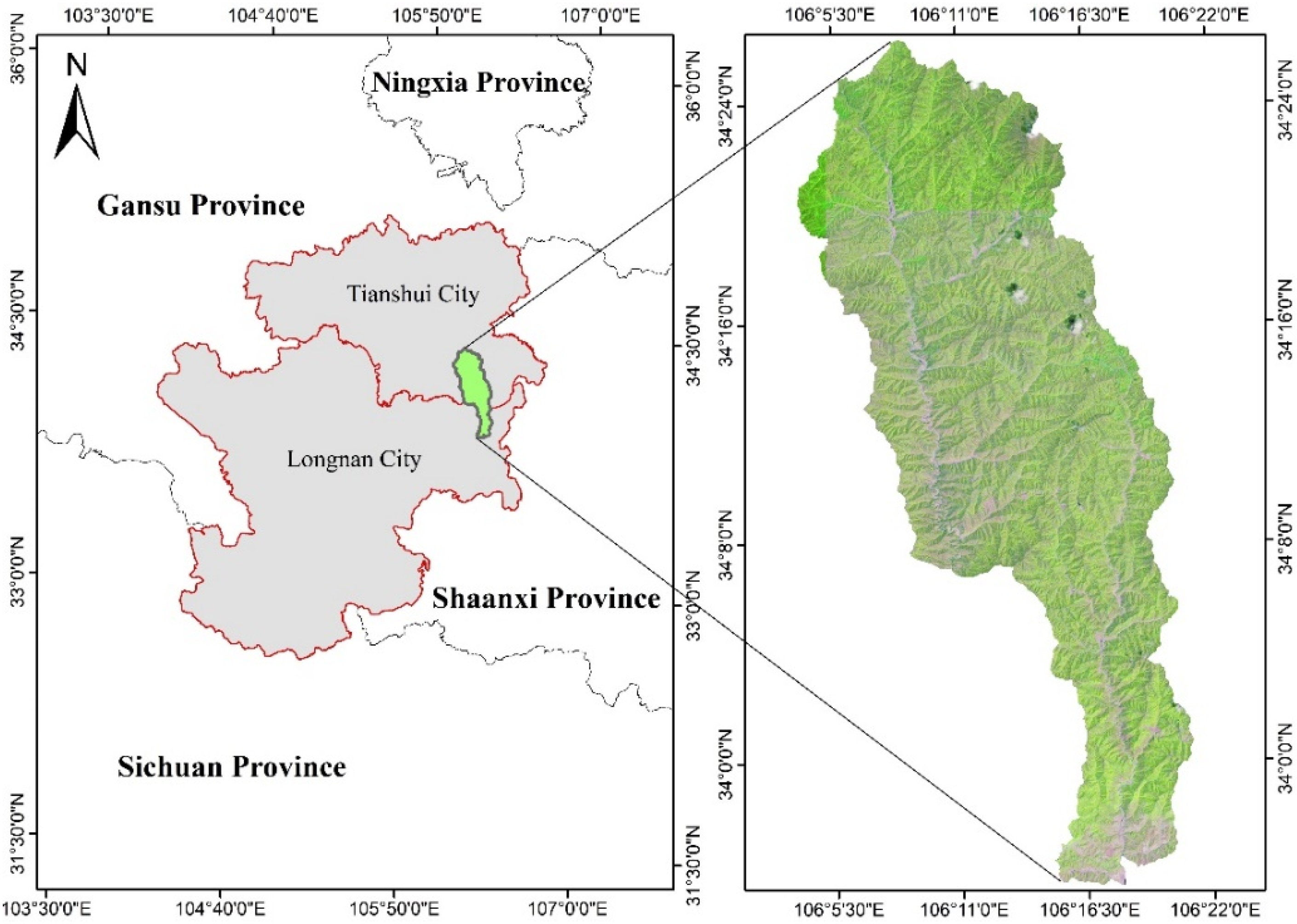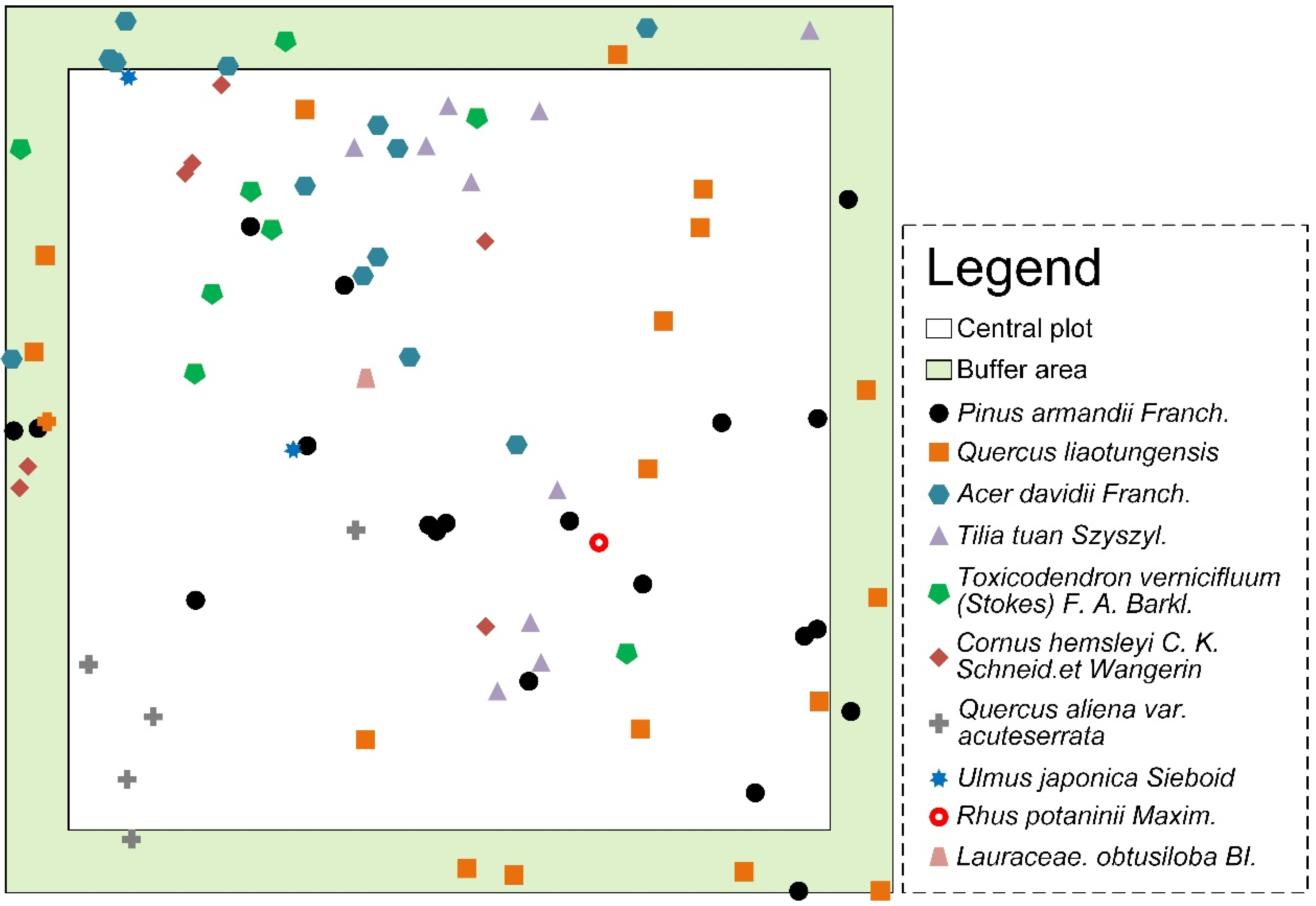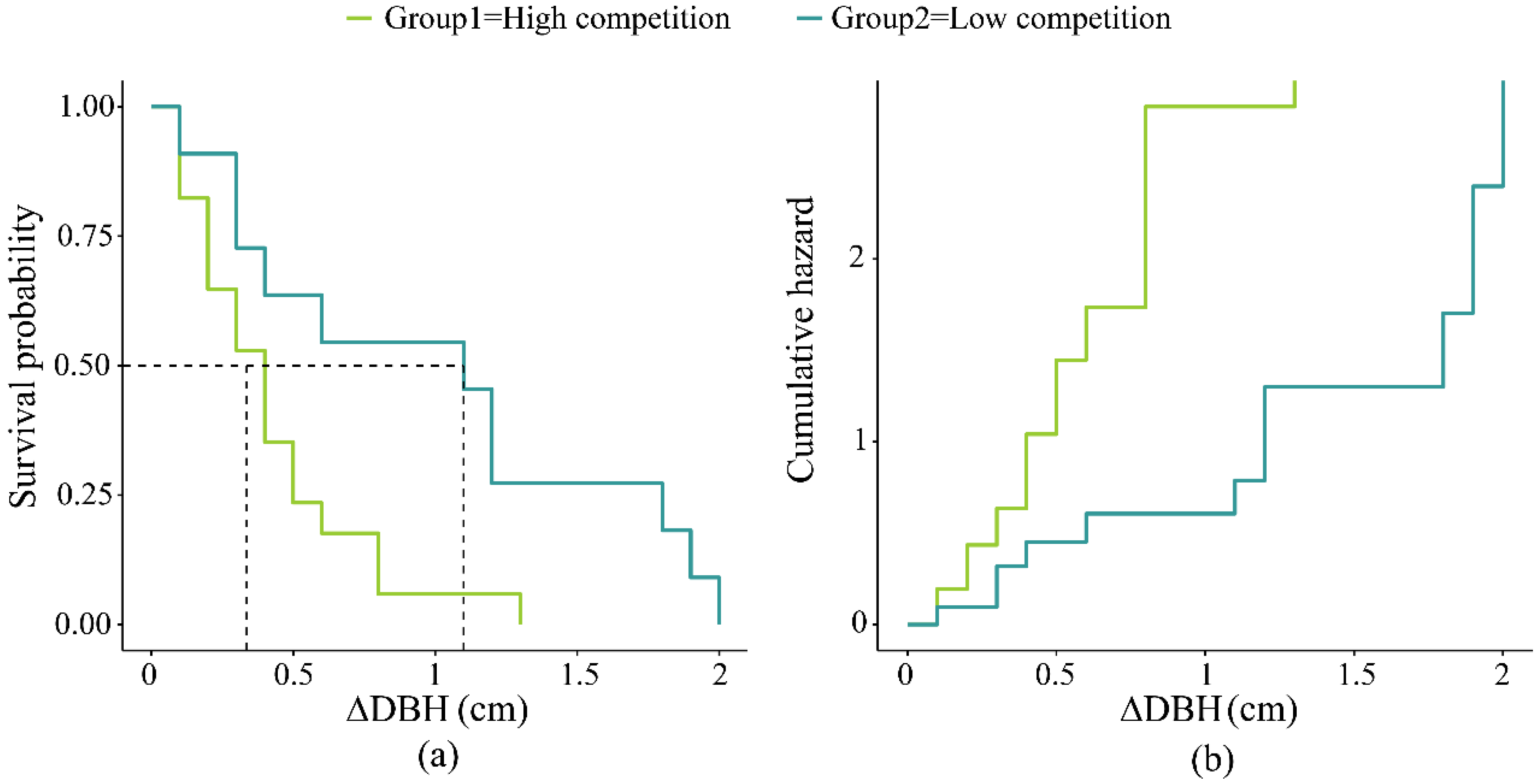Quantifying the Effect of Crown Vertical Position on Individual Tree Competition: Total Overlap Index and Its Application in Sustainable Forest Management
Abstract
1. Introduction
2. Materials and Methods
2.1. Study Area and Data Collection
2.2. Selection of the Subject Trees and Neighbor Trees
2.3. TOI Model Algorithm
2.3.1. Shading Modification Cofficient
2.3.2. Crowding Modification Cofficient
2.4. Individual-Tree Simulation
2.5. Growth Model
2.6. Survival and Hazard Analysis
2.7. Statistical Analysis
3. Results
3.1. Vertical Dimension Representational Ability
3.2. Growth Model
3.3. Kaplan–Meier Survival Analysis and Cox Proportional-Hazards Analysis
4. Discussion
5. Conclusions
Author Contributions
Funding
Acknowledgments
Conflicts of Interest
References
- Peng, C. Understanding the role of forest simulation models in sustainable forest management. Environ. Impact Assess. Rev. 2000, 20, 481–501. [Google Scholar] [CrossRef]
- Ford, E.D.; Sorrensen, K.A. Theory and models of inter-plant competition as a spatial process. In Individual-Based Models and Approaches in Ecology: Populations, Communities, and Ecosystems; Taylor & Francis: Abingdon, UK, 1992; pp. 363–407. [Google Scholar]
- Zhang, J.; Huang, S.; He, F. Half-century evidence from western Canada shows forest dynamics are primarily driven by competition followed by climate. Proc. Natl. Acad. Sci. USA 2015, 112, 4009–4014. [Google Scholar] [CrossRef] [PubMed]
- Fujimori, T. Ecological and Silvicultural Strategies for Sustainable Forest Management; Elsevier: Amsterdam, The Netherlands, 2001. [Google Scholar]
- Weiskittel, A.R.; Hann, D.W.; Kershaw, J.A., Jr.; Vanclay, J.K. Forest Growth and Yield Modeling; John Wiley & Sons: Hoboken, NJ, USA, 2011. [Google Scholar]
- Vanclay, J.K.; Skovsgaard, J.P. Evaluating forest growth models. Ecol. Model. 1997, 98, 1–12. [Google Scholar] [CrossRef]
- Aarssen, L.W. Interpretation of the evolutionary consequences of competition in plants: An experimental approach. Oikos 1985, 45, 99–109. [Google Scholar] [CrossRef]
- Brooker, R.W.; Kikvidze, Z. Importance: An overlooked concept in plant interaction research. J. Ecol. 2008, 96, 703–708. [Google Scholar] [CrossRef]
- Hegyi, F. A simulation model for managing jack-pine standssimulation. RoyalColl. For. Res. Notes 1974, 30, 74–90. [Google Scholar]
- Pretzsch, H. Forest Dynamics, Growth, and Yield; Springer: Berlin/Heidelberg, Germany, 2009; pp. 1–39. [Google Scholar]
- Hui, G.; Wang, Y.; Zhang, G.; Zhao, Z.; Bai, C.; Liu, W. A novel approach for assessing the neighborhood competition in two different aged forests. For. Ecol. Manag. 2018, 422, 49–58. [Google Scholar] [CrossRef]
- Tomé, M.; Burkhart, H.E. Distance-dependent competition measures for predicting growth of individual trees. For. Sci. 1989, 35, 816–831. [Google Scholar]
- Lee, W.-K.; Von Gadow, K. Iterative bestimmung der konkurrenzbäume in Pinus densiflora Beständen. Allg. Forst-und Jagdztg. 1997, 168, 41–45. [Google Scholar]
- Glover, G.R.; Hool, J.N. A basal area ratio predictor of loblolly pine plantation mortality. For. Sci. 1979, 25, 275–282. [Google Scholar]
- Biging, G.S.; Dobbertin, M. A comparison of distance-dependent competition measures for height and basal area growth of individual conifer trees. For. Sci. 1992, 38, 695–720. [Google Scholar]
- Pukkala, T.; Kolström, T. Competition indices and the prediction of radial growth in Scots pine. Silva Fenn. 1987, 21, 55–67. [Google Scholar] [CrossRef]
- Hann, D.W.; Ritchie, M.W. Height growth rate of Douglas-fir: A comparison of model forms. For. Sci. 1988, 34, 165–175. [Google Scholar]
- Krajicek, J.E.; Brinkman, K.A.; Gingrich, S.F. Crown competition—A measure of density. For. Sci. 1961, 7, 35–42. [Google Scholar]
- Soares, P.; Tomé, M. GLOBTREE: An individual tree growth model for Eucalyptus globulus in Portugal. In Modelling Forest Systems; CAB International: Wallingford, CT, USA, 2003; pp. 97–110. [Google Scholar]
- Munro, D.D. Forest growth models-a prognosis. In Growth Models for Tree and Stand Simulation; Department of Forest Yield Research, Royal College of Forestry: Stockholm, Sweden, 1974; Volume 30, pp. 7–21. [Google Scholar]
- Arney, J.D. Tables for Quantifying Competitive Stress on Individual Trees. Inf. Rep. BC-X-78. Canadian Forestry Service, Pacific Forest Research Center: Victoria, BC, Canada, 1973. Available online: https://cfs.nrcan.gc.ca/pubwarehouse/pdfs/26500.pdf (accessed on 1 March 2020).
- Daniels, R.F. Simple competition indices and their correlation with annual loblolly pine tree growth. For. Sci. 1976, 22, 454–456. [Google Scholar]
- Bella, I. A new competition model for individual trees. For. Sci. 1971, 17, 364–372. [Google Scholar]
- Ek, A.; Monserud, R. Forest: A Computer Model for Simulating the Growth and Reproduction of Mixed Species Forest Stands; University of Wisconsin: Madison, WI, USA, 1974. [Google Scholar] [CrossRef]
- Contreras, M.A.; Affleck, D.; Chung, W. Evaluating tree competition indices as predictors of basal area increment in western Montana forests. For. Ecol. Manag. 2011, 262, 1939–1949. [Google Scholar] [CrossRef]
- Danalatos, N.G.; Archontoulis, S.V.; Mitsios, I. Potential growth and biomass productivity of Miscanthus × giganteus as affected by plant density and N-fertilization in central Greece. Biomass Bioenergy 2007, 31, 145–152. [Google Scholar] [CrossRef]
- Kucharik, C.J.; Norman, J.M.; Gower, S.T. Characterization of radiation regimes in nonrandom forest canopies: Theory, measurements, and a simplified modeling approach. Tree Physiol. 1999, 19, 695–706. [Google Scholar] [CrossRef]
- Van Pelt, R.; North, M.P. Analyzing canopy structure in Pacific Northwest old-growth forests with a stand-scale crown model. Northwest Sci. 1996, 70, 15–30. [Google Scholar]
- Hatch, C.R.; Gerrard, D.J.; Tappeiner, J.C., II. Exposed crown surface area: A mathematical index of individual tree growth potential. Can. J. For. Res. 1975, 5, 224–228. [Google Scholar] [CrossRef]
- Opie, J.E. Predictability of individual tree growth using various definitions of competing basal area. For. Sci. 1968, 14, 314–323. [Google Scholar]
- Daniels, R.F.; Burkhart, H.E.; Clason, T.R. A comparison of competition measures for predicting growth of loblolly pine trees. Can. J. For. Res. 1986, 16, 1230–1237. [Google Scholar] [CrossRef]
- Tennent, R. Competition quotient in young Pinus radiate. N. Z. J. For. Sci. 1975, 5, 230–234. [Google Scholar]
- Martin, G.L.; Ek, A.R. A comparison of competition measures and growth models for predicting plantation red pine diameter and height growth. For. Sci. 1984, 30, 731–743. [Google Scholar]
- Freckleton, R.; Watkinson, A. Asymmetric competition between plant species. Funct. Ecol. 2001, 15, 615–623. [Google Scholar] [CrossRef]
- Schwinning, S.; Weiner, J. Mechanisms determining the degree of size asymmetry in competition among plants. Oecologia 1998, 113, 447–455. [Google Scholar] [CrossRef] [PubMed]
- Kitikidou, K.; Apostolopoulou, E. Applying survival analysis for assessment of forests sustainable development. Renew. Sustain. Energy Rev. 2011, 15, 851–855. [Google Scholar] [CrossRef]
- Waters, W.E. The life table approach to analysis of insect impact. J. For. 1969, 67, 300–304. [Google Scholar]
- Zens, M.S.; Peart, D.R. Dealing with death data: Individual hazards, mortality and bias. Trends Ecol. Evol. 2003, 18, 366–373. [Google Scholar] [CrossRef]
- Bigler, C.; Bugmann, H. Assessing the performance of theoretical and empirical tree mortality models using tree-ring series of Norway spruce. Ecol. Model. 2004, 174, 225–239. [Google Scholar] [CrossRef]
- Bigler, C.; Bugmann, H. Predicting the time of tree death using dendrochronological data. Ecol. Appl. 2004, 14, 902–914. [Google Scholar] [CrossRef]
- Canham, C.D.; LePage, P.T.; Coates, K.D. A neighborhood analysis of canopy tree competition: Effects of shading versus crowding. Can. J. For. Res. 2004, 34, 778–787. [Google Scholar] [CrossRef]
- Husch, B.; Beers, T.W.; Kershaw, J.A., Jr. Forest Mensuration; John Wiley & Sons: Hoboken, NJ, USA, 2002. [Google Scholar]
- Canham, C.D.; Papaik, M.J.; Uriarte, M.; McWilliams, W.H.; Jenkins, J.C.; Twery, M.J. Neighborhood analyses of canopy tree competition along environmental gradients in new england forests. Ecol. Appl. 2006, 16, 540–554. [Google Scholar] [CrossRef]
- Groot, A. A model to estimate light interception by tree crowns, applied to black spruce. Can. J. For. Res. 2004, 34, 788–799. [Google Scholar] [CrossRef]
- Stadt, K.J.; Lieffers, V.J. MIXLIGHT: A flexible light transmission model for mixed-species forest stands. Agric. For. Meteorol. 2000, 102, 235–252. [Google Scholar] [CrossRef]
- Hanus, M.L. Modeling Light Competition in the Forests of Western Oregon. Ph.D. Thesis, Oregon State University, Corvallis, OR, USA, 2003. [Google Scholar]
- Hans, P. Forest Dynamics, Growth and Yield: From Measurement to Model; Springer: Berlin/Heidelberg, Germany, 2009. [Google Scholar]
- Wykoff, W.R. A basal area increment model for individual conifers in the northern Rocky Mountains. For. Sci. 1990, 36, 1077–1104. [Google Scholar]
- Kiernan, D.H.; Bevilacqua, E.; Nyland, R.D. Individual-tree diameter growth model for sugar maple trees in uneven-aged northern hardwood stands under selection system. For. Ecol. Manag. 2008, 256, 1579–1586. [Google Scholar] [CrossRef]
- Efron, B. Estimating the error rate of a prediction rule: Improvement on cross-validation. J. Am. Stat. Assoc. 1983, 78, 316–331. [Google Scholar] [CrossRef]
- Yang, Y.; Huang, S. Suitability of five cross validation methods for performance evaluation of nonlinear mixed-effects forest models–A case study. Forestry 2014, 87, 654–662. [Google Scholar] [CrossRef]
- Cox, D.R.; Oakes, D. Analysis of Survival Data; CRC Press: Boca Raton, FL, USA, 1984; Volume 21. [Google Scholar]
- Rivas, J.C.; González, J.Á.; Aguirre, O.; Hernandez, F. The effect of competition on individual tree basal area growth in mature stands of Pinus cooperi Blanco in Durango (Mexico). Eur. J. For. Res. 2005, 124, 133–142. [Google Scholar] [CrossRef]
- Anning, A.K.; McCarthy, B.C. Competition, size and age affect tree growth response to fuel reduction treatments in mixed-oak forests of Ohio. For. Ecol. Manag. 2013, 307, 74–83. [Google Scholar] [CrossRef]
- Kahriman, A.; Şahin, A.; Sönmez, T.; Yavuz, M. A novel approach to selecting a competition index: The effect of competition on individual-tree diameter growth of Calabrian pine. Can. J. For. Res. 2018, 48, 1217–1226. [Google Scholar] [CrossRef]
- McTague, J.; Weiskittel, A. Individual-tree competition indices and improved compatibility with stand-level estimates of stem density and long-term production. Forests 2016, 7, 238. [Google Scholar] [CrossRef]
- Fernández-Manjarrés, J.F.; Ruiz-Benito, P.; Zavala, M.A.; Camarero, J.J.; Pulido, F.; Proença, V.; Navarro, L.; Sansilvestri, R.; Granda, E.; Marqués, L. Forest adaptation to climate change along steep ecological gradients: The case of the Mediterranean-temperate transition in South-Western Europe. Sustainability 2018, 10, 3065. [Google Scholar] [CrossRef]
- Linares, J.C.; Camarero, J.J.; Carreira, J.A. Competition modulates the adaptation capacity of forests to climatic stress: Insights from recent growth decline and death in relict stands of the Mediterranean fir Abies pinsapo. J. Ecol. 2010, 98, 592–603. [Google Scholar] [CrossRef]
- de Toledo, J.J.; Magnusson, W.E.; Castilho, C.V. Competition, exogenous disturbances and senescence shape tree size distribution in tropical forest: Evidence from tree mode of death in C entral A mazonia. J. Veg. Sci. 2013, 24, 651–663. [Google Scholar] [CrossRef]
- Pukkala, T.; Lähde, E.; Laiho, O. Growth and yield models for uneven-sized forest stands in Finland. For. Ecol. Manag. 2009, 258, 207–216. [Google Scholar] [CrossRef]
- Hann, D.W.; Wang, C.-H. Mortality Equations for Individual Trees in the Mixed-Conifer Zone of Southwest Oregon; Oregon State University: Corvallis, OR, USA, 1990. [Google Scholar]
- Yang, Y.; Titus, S.J. Maximum size–density relationship for constraining individual tree mortality functions. For. Ecol. Manag. 2002, 168, 259–273. [Google Scholar] [CrossRef]







| NO. | Slope (°) | Altitude (m) | Density (Tree ha −1) | DBH (cm) | Average Tree Height (m) | Coordinates | |||
|---|---|---|---|---|---|---|---|---|---|
| Min | Max | Mean | Latitude (N) | Longitude (E) | |||||
| 1 | 30 | 1757 | 575 | 4.6 | 41 | 16.67 | 16.4 | 34.19279° | 106.26594° |
| 2 | 29 | 1745 | 750 | 4 | 50 | 13.67 | 14 | 34.19352° | 106.26579° |
| 3 | 35 | 1770 | 1000 | 4.3 | 41.4 | 13.51 | 14.7 | 34.19337° | 106.26573° |
| 4 | 31 | 1776 | 1025 | 4.8 | 51 | 13.06 | 14.8 | 34.19396° | 106.26570° |
| 5 | 37 | 1712 | 1425 | 4 | 27.8 | 10.91 | 11 | 34.25348° | 106.23327° |
| 6 | 37 | 1723 | 2175 | 4.1 | 31.3 | 9.50 | 10.5 | 34.25264° | 106.23339° |
| Model | Parameter Estimates | Model Fitting | ||||||||
|---|---|---|---|---|---|---|---|---|---|---|
| b0 | b1 | b2 | b3 | b4 | b5 | AIC | LL | LRT | p-Value | |
| Initial model | 4.675 *** | 5.535 *** | 4.265 *** | −2.872 ** | 2.481 * | −3.859 *** | 1050.27 | −517.13 | ||
| Initial model with AR(1) | 3.770 *** | 5.464 *** | 4.459 *** | −2.214 * | 2.368 * | −3.661 *** | 1042.83 | −512.42 | 9.437 | 0.0021 ** |
| Selected CI | Model Fitting | Cross-Validation | |||
|---|---|---|---|---|---|
| AIC | LL | MRE | MAPE | RMSE | |
| Benchmark CI (SCI) | 1042.83 | −512.42 | −35.46% | 122.05% | 0.8053 |
| TOI | 1041.60 | −511.80 | −28.67% | 117.11% | 0.7993 |
| AOM | 1042.44 | −512.22 | −28.88% | 118.87% | 0.8049 |
| Hegyi index | 1054.96 | −518.48 | −37.53% | 127.81% | 0.8174 |
| Variable | Cofficient | Hazard Ratio | Wald Test (p-Value) | Likehood Radio Test (p-Value) | Logrank Test (p-Value) |
|---|---|---|---|---|---|
| TOI | −1.0703 | 0.3429 | 5.62 (0.02 *) | 6.11 (0.01 *) | 6.04 (0.01 *) |
© 2020 by the authors. Licensee MDPI, Basel, Switzerland. This article is an open access article distributed under the terms and conditions of the Creative Commons Attribution (CC BY) license (http://creativecommons.org/licenses/by/4.0/).
Share and Cite
Wang, B.; Bu, Y.; Tao, G.; Yan, C.; Zhou, X.; Li, W.; Zhao, P.; Yang, Y.; Gou, R. Quantifying the Effect of Crown Vertical Position on Individual Tree Competition: Total Overlap Index and Its Application in Sustainable Forest Management. Sustainability 2020, 12, 7498. https://doi.org/10.3390/su12187498
Wang B, Bu Y, Tao G, Yan C, Zhou X, Li W, Zhao P, Yang Y, Gou R. Quantifying the Effect of Crown Vertical Position on Individual Tree Competition: Total Overlap Index and Its Application in Sustainable Forest Management. Sustainability. 2020; 12(18):7498. https://doi.org/10.3390/su12187498
Chicago/Turabian StyleWang, Boheng, Yuankun Bu, Guanhu Tao, Chenran Yan, Xiaolu Zhou, Weizhong Li, Pengxiang Zhao, Yanzheng Yang, and Ruikun Gou. 2020. "Quantifying the Effect of Crown Vertical Position on Individual Tree Competition: Total Overlap Index and Its Application in Sustainable Forest Management" Sustainability 12, no. 18: 7498. https://doi.org/10.3390/su12187498
APA StyleWang, B., Bu, Y., Tao, G., Yan, C., Zhou, X., Li, W., Zhao, P., Yang, Y., & Gou, R. (2020). Quantifying the Effect of Crown Vertical Position on Individual Tree Competition: Total Overlap Index and Its Application in Sustainable Forest Management. Sustainability, 12(18), 7498. https://doi.org/10.3390/su12187498




